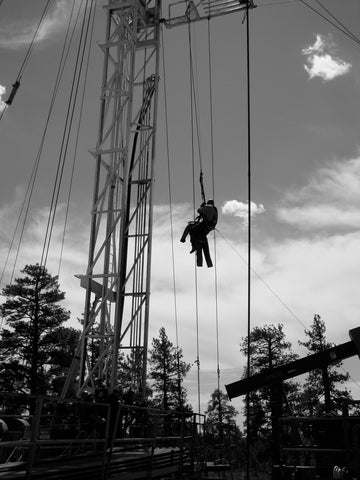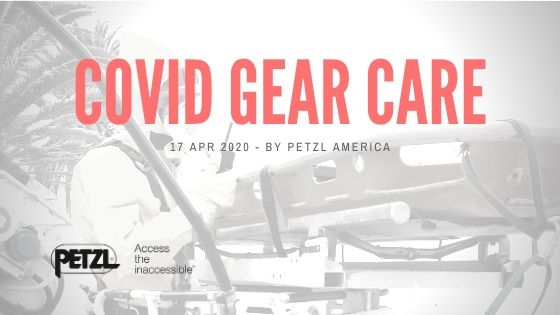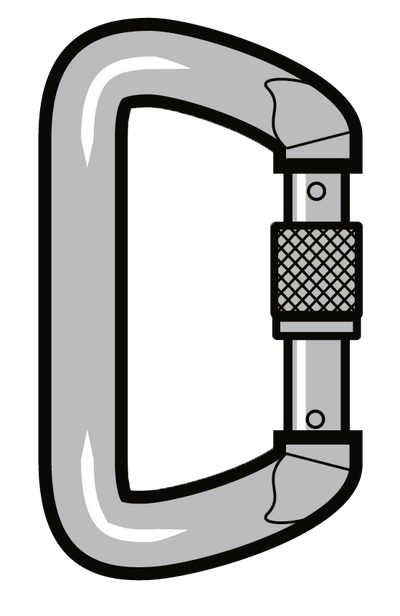Ask a Pro: What is Suspension Trauma (aka Harness Hang Syndrome)?
_____________________________________________________________________
Since many of our clients work at height or in the emergency services (or both) we know that proper fall protection is critical to getting the job done safely. When a worker’s fall-arrest system prevents a fall from height, it has certainly saved that person from the trauma of the fall. However, they may now be in danger of an equally life-threatening emergency: Suspension Trauma.
So what exactly is Suspension Trauma?
 Suspension Trauma (also called Orthostatic Intolerance, or Harness Hang Syndrome) is the loss of consciousness due to a victim being held upright with limited movement for a period of time, which can rapidly lead to death if not properly recognized and treated.
Suspension Trauma (also called Orthostatic Intolerance, or Harness Hang Syndrome) is the loss of consciousness due to a victim being held upright with limited movement for a period of time, which can rapidly lead to death if not properly recognized and treated.
Why does it happen?
The short answer is because too much blood gets trapped in your legs and you aren't able to adequately supply your brain with sufficient oxygen. For starters, consider what happens to the blood in your body in a normal situation. Obviously, your heart is pumping blood into your legs, but gravity is also helping to ‘pull’ that blood towards the ground and keep it there. Clearly, the blood can’t be allowed to just stay in the legs. So, to return it to the heart the body depends on 4 major methods: the one-way valves in your veins, your skeletal-muscle pump, your venous smooth muscles, and the thoracic pump mechanism.
- The one-way valves in your veins. Veins are the blood vessels that bring blood back to the heart, and they’re filled with valves that only let blood flow in one direction: towards the heart.
-
 Your Skeletal-Muscle Pump. In this case, referring primarily to your leg muscles, every time your muscles contract, they get shorter and thicker and press against anything else around them (like your veins and the blood contained therein). The compression of the veins causes the blood to get pushed out of the way, and because of the one-way valves preventing backflow, this means towards the heart.
Your Skeletal-Muscle Pump. In this case, referring primarily to your leg muscles, every time your muscles contract, they get shorter and thicker and press against anything else around them (like your veins and the blood contained therein). The compression of the veins causes the blood to get pushed out of the way, and because of the one-way valves preventing backflow, this means towards the heart.
-
Your smooth muscles. Your veins also have small muscles surrounding them classified as smooth muscles (tunica media). These muscles control the diameter of the blood vessels and affect what’s known as the “tone” of your vascular system. When these muscles contract, the diameter of the veins decreases, raising the blood pressure. Remember that the one-way valves keep blood flowing towards the heart, so if the same volume of blood keeps entering a smaller pipe, the blood’s velocity will have to increase, returning blood more quickly to the heart.

- The Thoracic Pump Mechanism. This one is somewhat complicated, so unless you want a medical degree, feel free to skip this and just know it exists. For those of you who are ambitious, the basics are as follows: as you inhale, the mediastinal intrapleural pressure becomes more negative, leading to expansion of the lungs, and pressure drops in the RA, RV, SVC, and IVC. Right Atrial expansion increases preload and raises the stroke volume, and most importantly for our understanding, increases the pressure gradient for venous return (Klabunde).
In Suspension Trauma, there are two key factors (and a possible third) which come into play, each of which severely impair blood from returning to your heart to supply oxygen to the brain: 1) a lack of movement, 2) body weight in the harness compressing veins, and possibly 3) a buildup of toxins in the blood (read below for more).
-
Remember how we said that in Suspension Trauma the victim was held upright with limited movement? And remember how we said that contracting your leg muscles helps squeeze blood back to the heart? Well if you can’t move, (perhaps because of the harness, fatigue, injury or a combination) then that Skeletal-Muscle Pump can’t squeeze blood back to the heart as per normal. Ok, so what if you consciously flexed your quads and hamstrings in your legs while hanging, wouldn’t that prevent Suspension Trauma? For a while – yes. Forever - no. There’s no question moving around helps prevent Suspension Trauma, but it won’t stop it. Eventually, fatigue becomes an issue.
-
The other issue is that your body weight hanging in the harness can pinch off some important veins, specifically your femoral vein running along the inside of your thigh. As you can probably guess, this severely limits how easily blood can be moved back to the heart. For various physiological reasons, veins are very pliable (compared to arteries) and, as a result, they can be pinched closed even easier. The end result – blood is getting stuck in your legs.
-
This last point is unproven by scientific studies but does get talked about so much online I’ll mention it. Called Reflow Syndrome, the idea is that as blood pools in the patient’s legs, there’s less blood available to supply oxygen to the rest of the body’s tissues. As a result, organs and muscles produce nasty toxic waste products in order to survive and if the concentration of toxins in the blood increases enough, the patient could die. However, this supposed phenomenon does not play a roll in causing Harness Hang Syndrome. Despite what people might say on the internet, studies have found no evidence of Reflow Syndrome in Suspension Trauma (Thomassen et al. 896-8) (Adisesh, Lee, and Porter 265-8).

Why does it matter?
This matters because the more blood stuck in your legs, the less blood that’s available for the rest of your body, especially your brain. When a normal person gets up out of bed, gravity helps ‘pull’ a little extra blood into their legs. Lying down you can expect about 12-15% of your total blood to be in your legs. When you stand up, you can expect that to increase to about 19-22% (Asmussen 33-34). Since there is more blood staying in your legs, there is less blood in your heart. This causes your blood pressure to fall slightly and your heart rate to increase slightly to compensate. For healthy people, we can use the 30-20-10 rule. Heart rate will increase by no more than 30 bpm, systolic blood pressure will fall by no more than 20 mm/Hg, and diastolic blood pressure will fall by no more than 10 mm/Hg. Within minutes of standing up your body compensates for your new position by shrinking the size of your arteries (which carry blood away from your heart to your legs), relaxing the smooth muscles around your veins (to dilate them), and using your skeletal muscles to squeeze the blood back.
However, with Suspension Trauma, we already know that the blood is not getting back to the heart effectively. As more and more blood gets trapped in the legs, less and less blood is available for the rest of the body and the brain. Blood pressure continues to drop and heart rate keeps rising, but adequate oxygenation is still not attainable.
If this isn’t intuitive, think about a fire pump. If there’s less water, you have less pressure at the nozzle, and if you don’t have enough water to maintain your prime, the centrifugal pump will overspeed. Your heart works the exact same way; less blood causes a drop in pressure and an increase in speed (or heart rate).
As this cycle progresses, the person hanging in their harness will start to experience symptoms such as sweating, pallor, shortness of breath, blurred vision, nausea, dizziness, and numbness in the legs. Eventually, the oxygen delivery by the blood to the brain will be so severely reduced that the person loses consciousness. If a person standing up loses consciousness, we call this fainting. The person collapses to the ground and any excess blood that has pooled in the legs is able to return to the heart much more easily. However, in Suspension Trauma, the person is held in an upright position because of their harness and, as a result, the patient’s blood pressure continues to fall and if not rescued immediately, can progress quickly towards death.
Prevention
As with almost all accidents, prevention is key. When working in an area where suspension is possible, have a rescue plan in place to ensure a rapid and safe rescue. One study found that the average onset of symptoms in a full body harness was 14 minutes (Orzech et al. 19) and, while I couldn’t find the original publication, many sources online suggest that symptoms will develop in under 10 minutes. Regardless of the exact timing, immediate rescue is necessary.
Symptoms of Suspension Trauma can vary widely and depend on many factors, a significant one being the type of harness worn as those that constrict the legs more and which do not allow for as much movement when hanging can lead to a faster onset of symptoms.
Should you ever find yourself suspended, immediately call or signal for help. Use suspension trauma straps or tie a long prusik onto your rope and step into it. This takes the compressive weight off of your legs and helps blood return back to the heart. If this is not an option, keep moving your legs as best you can and try leaning back into a semi-recumbent position to improve blood flow return (Pasquier 169). While easier said than done, always try to remain calm and take regular deep breaths without hyperventilating.
Treatment
*This is not medical advice and should not be considered as such. Refer to your training and follow whatever guidelines you’ve been instructed.
For informational purposes, I do want to point out some changes to treatment protocols that some groups have undertaken based on recent evidence. Arguably the biggest development was an evidence-based review published by the Health and Safety Executive in the U.K. in 2009. This review recommends that all post-suspension patients be placed in a fully horizontal position for recovery and treatment. Previous guidelines based on the 1972 conference in Innsbruck recommended that these patients be placed semi-sitting at a 30-degree angle. The rationale was that Reflow Syndrome (remember that from before?) would cause a rapid rush of toxins built up in the legs to return to circulation and cause the patient to go into shock and possibly die. However, I as was noted earlier, no scientific evidence has been found to support Reflow Syndrome in Suspension Trauma and, along with the findings from the HSE Review, more and more agencies are recommending that patients be treated in a fully horizontal position after rescue.
More Information
To read Joel's full paper on this topic, you can click here
For more info about the HSE Review, check out the entire publication here
References:
- Klabunde, R. "Factors promoting venous return." CVPhysiology.com. Web. October 17, 2015.
- Thomassen et al. "Does the horizontal position increase risk of rescue death following suspension trauma?" Emergency Medicine Journal. 26.12 (2009): 896-898. Web. October 17, 2015.
- Adisesh, A., Lee, C., Porter, K. "Harness suspension and first aid management: Development of an evidence-based guideline." Emergency Medicine Journal. 28.4 (2011): 265-268. Web. October 17, 2015
- Asmussen, E. "The Distribution of the Blood between the Lower Extremities and the Rest of the Body." Acta physiologica Scandinavica. 5.1 (1943): 31-38.
- Orzech et al. "Test Program to Evaluate Human Response to Prolonged Motionless Suspension in Three Types of Fall Protection Harnesses." U.S. Department of Defence: Defence Technical Information Centre. September 1, 1987. Web. October 17, 2015.
- Pasquier et al. "Clinical Update: Suspension Trauma." Wilderness and Environmental Medicine. 22.2 (2011): 167-171. Web. October 17, 2015.
Also in Blog

Check This Out - Freakin' Beacon
The "Freakin' Beacon"
User feedback was the driving force behind this design, Koehler BrightStar tells us, and it was important to have a product that was lightweight, durable and bright.
Weighing in at just 97 grams (yes, that includes 2x AAA batteries) and less than 7cm long, this unit is amazingly powerful for its small size.

RECOMMENDATIONS FOR DISINFECTING YOUR EQUIPMENT - Petzl
During the current COVID-19 crisis, many of you have sent us questions on how to disinfect your equipment. Here are the basics that you need to know.


